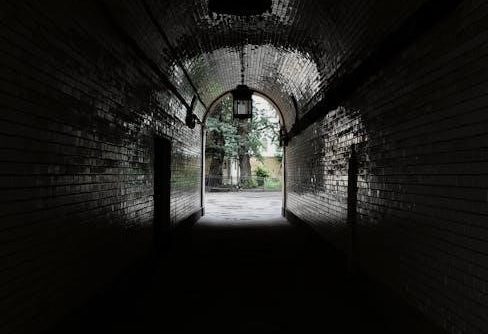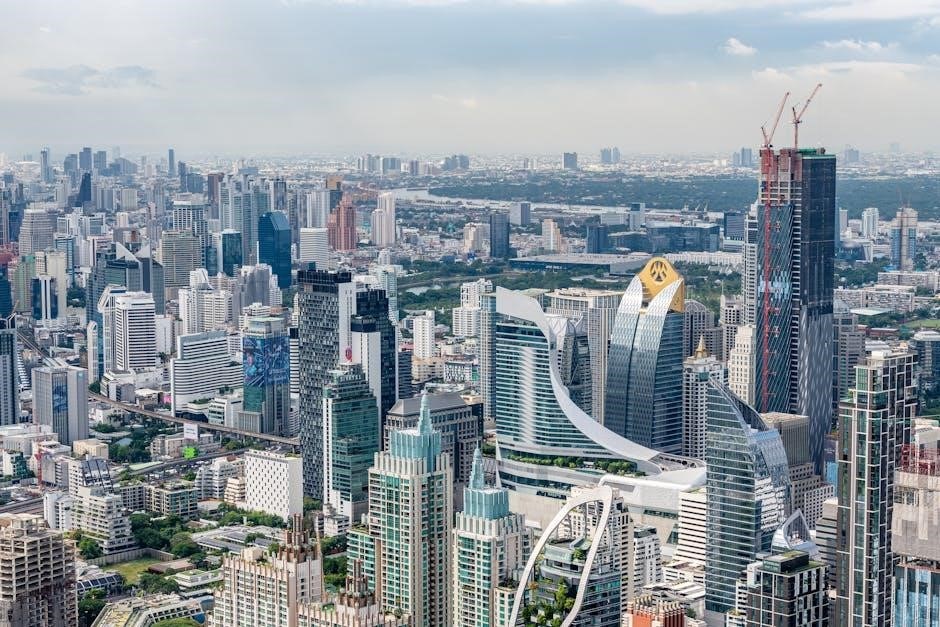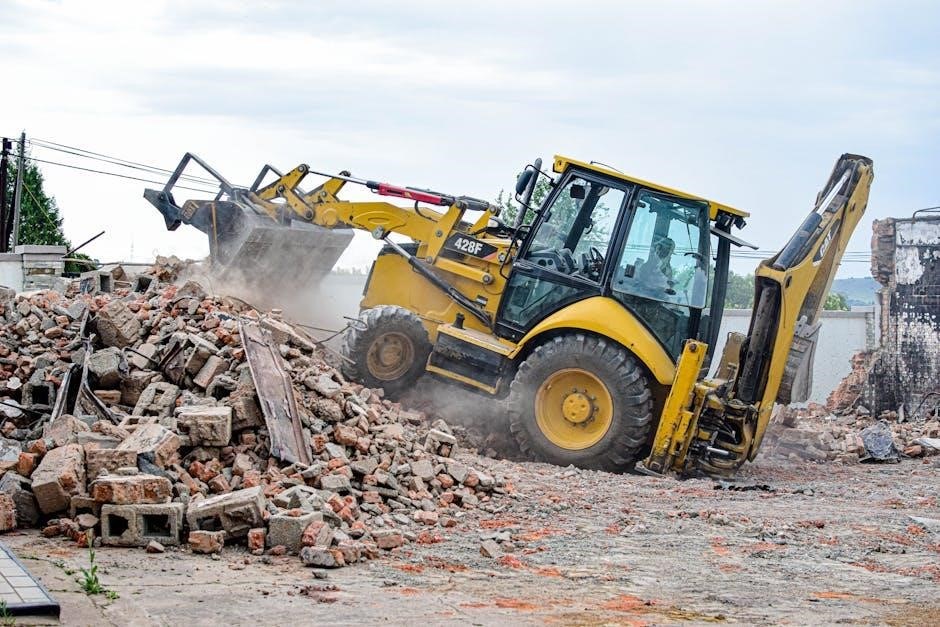
The Great Urban Transformation: An Overview
The Great Urban Transformation is a seminal work by You-tien Hsing‚ exploring China’s rapid urbanization and its socio-political implications. It examines land politics‚ property rights‚ and state-society dynamics‚ offering a structured analysis of urban change across regions‚ with a focus on civic territoriality and its impact on development.
Urban transformation refers to the profound changes in urban spaces‚ societies‚ and economies driven by rapid modernization and industrialization. In China‚ this process has been marked by unprecedented urbanization‚ reshaping the relationship between the state‚ society‚ and land. The concept underscores the interplay of political‚ economic‚ and social forces in redefining urban and rural landscapes. It highlights the role of land politics‚ property rights‚ and civic territoriality in driving urban expansion. This transformation is not just physical but also societal‚ reflecting shifts in power dynamics and wealth distribution. Understanding urban transformation requires examining its historical roots‚ regional variations‚ and the adaptive strategies of both state and society.
1.2 Historical Context of Urbanization in China
China’s urbanization is deeply rooted in its historical trajectory‚ shaped by state-led policies and economic reforms. The foundation of urban transformation began post-1949‚ with socialist restructuring emphasizing industrialization and collective land ownership. The 1978 reforms marked a turning point‚ as market-oriented policies spurred rapid urban expansion. Historical legacies‚ such as the hukou system and rural-urban divides‚ influenced urbanization patterns. The state’s role in land allocation and property rights has been central‚ often prioritizing economic growth over social equity. This historical context underscores how political and economic shifts have driven China’s urban transformation‚ creating both opportunities and challenges for sustainable development. Understanding this history is crucial for analyzing contemporary urban dynamics.
The Politics of Land and Property in China
The state plays a pivotal role in land allocation and property development‚ shaping urban transformation through policies that balance economic growth and social redistribution.
2.1 The Role of the State in Land and Property Development
The state plays a central role in China’s land and property development‚ driving urban transformation through strategic policies and land redistribution. By controlling land allocation‚ the government balances economic growth with social equity‚ ensuring that urban expansion aligns with national priorities. Civic territoriality‚ a concept highlighted in You-tien Hsing’s work‚ reflects the state’s influence in shaping spatial politics and property rights. This approach prioritizes public interest over private gain‚ fostering infrastructure development and housing projects that cater to urbanizing populations. The state’s interventions aim to mitigate disparities while sustaining economic momentum‚ illustrating the intricate interplay of power and policy in urban development.
2.2 Civic Territoriality and Its Impact on Urbanization

Civic territoriality plays a pivotal role in shaping China’s urbanization processes‚ as it defines how local governments and communities claim and manage urban spaces. This concept‚ central to You-tien Hsing’s analysis‚ highlights the spatial politics of land use‚ resource allocation‚ and property rights; By asserting control over territory‚ local actors influence urban growth patterns‚ balancing economic development with social equity. Civic territoriality fosters innovation in governance‚ enabling cities to adapt to rapid urbanization while addressing disparities. However‚ it also presents challenges‚ such as conflicts over land rights and uneven development. Ultimately‚ civic territoriality is a key driver of urban transformation‚ shaping the future of China’s cities and their integration into the global economy.

Urbanization Dynamics Across Different Regions
Urbanization processes vary significantly across regions in China‚ shaped by local economic conditions‚ policy frameworks‚ and territorial politics‚ leading to diverse patterns of growth and development.
3.1 Regional Variations in Urbanization Processes
Urbanization in China exhibits distinct regional variations‚ influenced by economic disparities‚ policy interventions‚ and territorial governance. Coastal regions‚ with their robust industrial bases and global connections‚ have experienced rapid urban expansion. In contrast‚ inland areas face slower growth due to limited resources and infrastructure. The state’s role in land allocation and property development varies across regions‚ shaping local urbanization trajectories. Civic territoriality further complicates these dynamics‚ as local governments balance development with community needs. These regional differences underscore the complex interplay of economic‚ political‚ and social factors in China’s urban transformation‚ leading to uneven development patterns and unique challenges for each area.

3.2 The Interplay Between Urban and Rural Areas
The interplay between urban and rural areas in China’s urban transformation is complex and multifaceted. Rapid urban expansion has led to the encroachment of rural land‚ sparking land disputes and displacement of rural communities. While urbanization brings economic opportunities‚ it also strains rural resources and exacerbates inequality. The state plays a pivotal role in mediating these dynamics‚ often prioritizing urban growth over rural development. Civic territoriality further influences how land is allocated and used‚ creating tensions between urban and rural interests. This interplay highlights the challenges of balancing development with equity‚ as rural areas struggle to adapt to the transformative pressures of urbanization.
Society-State Relations in Urban Transformation

The interplay between state and society is central to China’s urban transformation‚ with the state driving land policies and societal responses ranging from resistance to adaptation.
4.1 The Response of Society to Rapid Urban Expansion
Society’s response to rapid urban expansion in China has been varied‚ reflecting the complexities of state-society relations. While some communities have adapted to urbanization by engaging with development initiatives‚ others have shown resistance‚ particularly in cases of displacement. Inner-city residents have often exhibited confrontational resistance‚ as highlighted in case studies‚ while rural areas have seen more negotiated forms of adaptation. These responses underscore the uneven social dynamics driven by urban transformation‚ revealing both the resilience and vulnerability of different groups. The interplay between societal reactions and state policies highlights the multifaceted nature of urbanization‚ where cooperation and conflict coexist‚ shaping the trajectory of China’s urban future.
4.2 Resistance and Adaptation to Urbanization
Resistance and adaptation to urbanization in China have emerged as dual responses to the transformative forces reshaping communities. While some groups actively resist displacement through protests and legal challenges‚ others adapt by negotiating with authorities or seeking alternative livelihoods. Urbanization has created new social dynamics‚ where marginalized communities often bear the brunt of development. The interplay between resistance and adaptation reflects the complex power relations between the state and society. These responses not only highlight the challenges of urban expansion but also reveal the resilience of communities in navigating rapid change. The process underscores the tension between progress and preservation in China’s urban transformation journey.

Economic and Social Implications
Urban transformation in China has led to significant wealth distribution and economic inequality‚ influenced by property rights and land policies‚ reshaping social structures and disparities.
5.1 Wealth Distribution and Economic Inequality
The Great Urban Transformation highlights how China’s urbanization has exacerbated wealth disparities‚ with land policies and property rights disproportionately favoring elite groups. Rapid urban expansion has led to uneven wealth distribution‚ as rural areas often bear the costs of development while benefiting less from its gains. The commodification of land and housing has intensified economic inequality‚ creating stark contrasts between affluent urban centers and marginalized rural regions. These dynamics underscore the challenges of ensuring equitable growth amidst rapid modernization‚ raising critical questions about the sustainability of China’s development model and its impact on social cohesion.
5.2 The Role of Property Rights in Urban Development
Property rights play a pivotal role in shaping urban development in China‚ as highlighted in The Great Urban Transformation. The state’s control over land allocation and ownership structures significantly influences urbanization processes. The book emphasizes how property rights are often leveraged as tools for urban expansion‚ with the government balancing economic growth and social stability. However‚ the fragmented nature of property rights can lead to disparities in development opportunities across regions. This dynamic underscores the tension between public and private interests‚ illustrating how property rights frameworks are central to both the opportunities and challenges of urban transformation in China.

The Future of Urban Transformation in China
China’s urban transformation faces challenges of sustainability and social equity‚ requiring balanced policies to integrate urban and rural development while addressing environmental and demographic pressures.
6.1 Challenges and Opportunities for Sustainable Urbanization
China’s urban transformation presents significant challenges‚ including environmental degradation‚ social inequality‚ and resource depletion. Rapid urbanization has strained infrastructure and increased disparities between urban and rural areas. However‚ these challenges also offer opportunities for innovation and reform. Sustainable practices‚ such as green technology and inclusive urban planning‚ can address environmental and social concerns. Policy reforms focusing on balanced regional development and equitable resource distribution are crucial. Additionally‚ integrating urban and rural systems can enhance economic resilience and reduce migration pressures. By leveraging these opportunities‚ China can achieve a more sustainable and equitable urban future‚ ensuring long-term prosperity for its growing urban population.
6.2 The Path Forward for China’s Urban Development
China’s urban development must prioritize sustainable and inclusive growth to address current challenges. Policymakers should focus on integrated urban-rural systems‚ promoting balanced regional development. Green technology and eco-friendly infrastructure can mitigate environmental impacts. Strengthening property rights and fostering civic participation will enhance equity and accountability. Investing in education and innovation will drive economic resilience. Transparent governance and adaptive planning are essential to manage rapid urbanization effectively. By aligning development strategies with global sustainability goals‚ China can create livable‚ resilient cities that benefit all residents‚ ensuring a prosperous and environmentally conscious urban future.
The great urban transformation in China represents a complex interplay of economic‚ social‚ and political forces. This process has reshaped the nation’s landscape‚ creating both opportunities and challenges. Urbanization has driven economic growth but also intensified inequality and environmental pressures. The state’s role in land and property development has been central‚ yet societal responses and resistance highlight the need for inclusive policies. Moving forward‚ sustainable urbanization must balance growth with equity and environmental sustainability. By addressing these dynamics‚ China can pave the way for a more equitable and resilient urban future‚ ensuring that the benefits of transformation are shared by all.